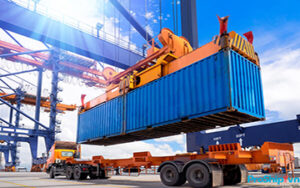When it comes to transporting goods, there are several key tips you should know before hiring a shipping service. Make a note of these for future reference.
Currently, the demand for cargo transportation is increasing, whether by road, sea, or air. The following tips will undoubtedly be very helpful when you need to transport goods.
1 Choose the Right Vehicle for Your Cargo Volume
Many customers, due to lack of experience, often choose trucks that are too large for the volume and size of their cargo. This can lead to increased costs and difficulties in loading, as oversized trucks can make it hard to secure the cargo properly. In some cases, oversized cargo may even violate traffic laws.
For container shipments, consider renting trucks without enclosed beds to facilitate easier loading and unloading. The demand for truck rentals in cities is quite high, from individuals moving houses to businesses relocating offices, setting up fairs, or delivering goods to agents.
Therefore, to select the appropriate truck and pricing package, accurately calculate the amount of cargo you need to transport and seek advice from service providers to ensure everything goes smoothly.
2 Select a Transport Company Near the Loading Area
In many provinces and cities, there are numerous transport companies. Choosing a company with a depot near the loading area ensures quick vehicle dispatch and cost savings, as the service vehicle won’t have to travel long distances to reach the loading site.
For large shipments from north to south or to other provinces, selecting a company with representative offices and depots in both regions is essential. This ensures all issues are handled quickly and efficiently, with costs minimized as transportation fees are only calculated for one-way trips.
3 Opt for Services with Reasonable Prices
The market offers various transport companies with different pricing. You might be confused when each company provides a different quote for the same pickup and delivery points. Concerns about timely delivery, potential shortages, or damage to goods are common among customers using transport services.
Therefore, choosing a reputable and reliable company with professional services is crucial. In Hanoi, several companies like Thần Đèn, Kiến Vàng, and 24h are highly rated for their quality, giving you peace of mind when using their services.
4 Considerations for Container Transportation
a. Is Container Transport Suitable?
This question might seem speculative, as you might only have a general idea of whether this transport method is suitable. However, in some cases, there are multiple options, and shippers may not know the best transport method for their needs. In such cases, analyze which shipments should be transported by sea container. Typically, these are:
- Goods with relatively large volumes (e.g., several dozen tons), which can be packed into one or more containers, transported domestically by sea from Hai Phong port to Saigon port or vice versa.
On this route, goods mainly move between these two ports. It’s rare for domestic container ships to call at other ports like Da Nang or Quy Nhon.
Note that this route only transports full container loads (FCL), not less-than-container loads (LCL). If you need to transport smaller volumes, a few tons (cubic meters) of goods, consider using North-South trucks instead.
b/ Types of Goods Unsuitable for Container Transport
Certain types of goods or shipments are not suitable for container transport. Here are some examples along with alternative methods:
- High-value goods requiring fast transport, such as jewelry and fresh flowers. These should be transported by air, which is more expensive but faster and safer.
- Large volume shipments (tens of thousands of tons or more), such as rice, ore, lime, and fertilizers. These are best transported by bulk carriers, with sizes suitable for the shipment.
- Goods requiring specialized ships, such as crude oil, liquefied gas, and automobiles. For smaller quantities, specialized containers can still be used.
c/ Exporting Goods by Container
- Contact Shipping Lines: Find a shipping line with a suitable schedule. Most routes have ships running on a fixed frequency, at least weekly, and there are usually multiple shipping lines to choose from.
- Request Freight Rates and Related Costs: Negotiate if possible. Be aware of additional charges, as they can be significantly higher than the sea freight itself.
- Book Space: Provide the shipping line with necessary information such as the name of the goods, number of containers, departure port, destination port, and estimated shipping date. They will send you a Booking Note.
- Load Goods into Containers and Transport to Port.
- Complete Export Customs Procedures.
- Prepare Documentation.
For imported goods where you handle the transportation (under terms like CIF or DDU), the process is similar. However, it’s advisable to work with a forwarder, as they have import sales staff, while shipping line sales staff usually focus on exports.
5. Choosing a Freight Service
- Determine the Characteristics, Size, and Weight of Goods: This helps in selecting the appropriate container type and size.
- For agricultural and forestry products, choose a refrigerated container with the required temperature.
- For smaller shipments, opt for a 20-foot container to reduce costs.
- Inspect the Container:
- Ensure the container is intact, without dents or mechanical deformations, and has a fresh, uniform paint job.
- The floor should be dry, clean, and free of holes.
- The roof and walls should be intact. Check by closing the container door slightly and looking for any light entering. If light is visible, choose another container to prevent seawater or rain from damaging the goods.
- Rubber seals on the container doors should be intact to prevent water and dust ingress during transport.
6. Types of Freight Service Fees
- Freight Fee: Based on the weight of the goods and the delivery location.
- COD Fee: Applies when the bill of lading includes cash on delivery, based on the published fee schedule.
- Overweight Fee: Applies when the shipment weight increases from the initial bill of lading (paid by the seller).
- Insurance Fee: If the customer purchases insurance, this fee is not included in the COD amount.
- Return Fee: Applies when the shipment is returned to the sender.
7. Prohibited Goods for Transport
- Narcotics and psychotropic substances.
- Weapons, ammunition, and military technical equipment.
- Obscene, reactionary cultural products; publications and documents aimed at disrupting public order against the Socialist Republic of Vietnam.
- Explosive, flammable substances, and other dangerous or unsanitary items that pollute the environment.
- Goods prohibited by the state from circulation, trade, export, or import.

